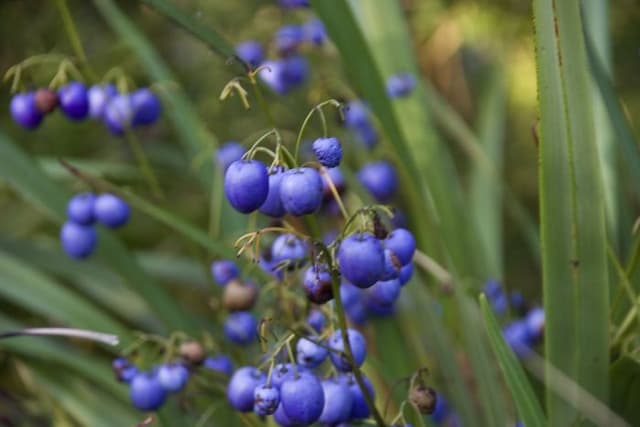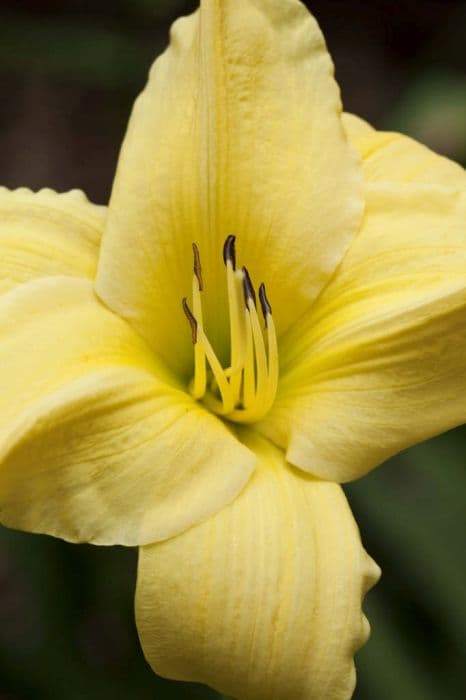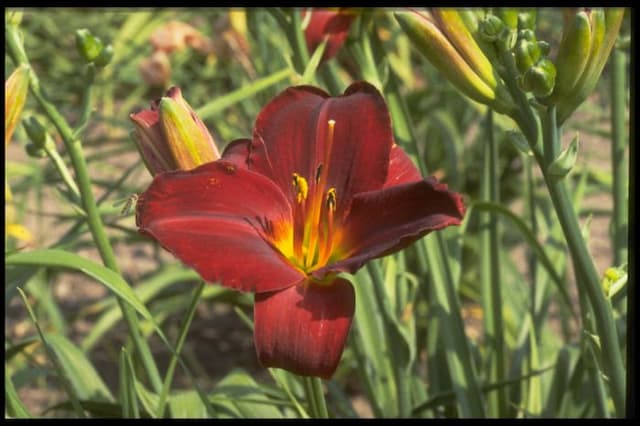Hemerocallis 'Anzac'

ABOUT
The Hemerocallis 'Anzac', commonly known as the Daylily 'Anzac', is a striking perennial plant known for its showy flowers and lush foliage. This plant produces large, bright flowers that are a deep, vibrant red color, often with a velvety texture and a contrasting golden-yellow throat. Each flower blooms for just a day, hence the name daylily, but the plant produces many buds that provide a succession of flowers over a period of weeks. The blossoms of the Daylily 'Anzac' have a trumpet-like shape, with petals that spread outward and may exhibit gentle ruffles along their edges. The petals often display a slightly recurved shape, curling back towards the stem and adding depth to the flower's appearance. At the center of each flower, the stamens are prominently visible, with their filament and anther adding fine detail against the bold backdrop of the petals. The foliage of the Daylily 'Anzac' consists of strappy, arching leaves that emerge from the base of the plant in a lush clump. The leaves are usually a rich green color, providing a fresh and vibrant look even when the plant is not in bloom. These leaves form a dense mound that can fill the garden space with texture and greenery. Overall, the Daylily 'Anzac' is admired for its ornamental beauty, with its bright red flowers and attractive foliage creating a standout presence in the garden that draws the eye and adds lively color to any planting area.
About this plant
 Names
NamesFamily
Hemerocallidaceae
Synonyms
Daylily, Anzac Daylily
Common names
Hemerocallis 'Anzac'.
 Toxicity
ToxicityTo humans
Daylily (Hemerocallis 'Anzac') is not known to be toxic to humans. In fact, daylilies are often used in culinary applications; their flowers and tubers are edible when properly prepared. However, as with any plant, individual allergies and adverse reactions can occur, so it is always recommended to exercise caution if you are not sure about the edibility or potential reactions.
To pets
For pets, specifically cats, the daylily is toxic and can be quite dangerous. Ingestion of any part of this plant can lead to acute kidney failure in cats. Symptoms of daylily poisoning in pets, particularly cats, include vomiting, lethargy, kidney failure signs like decreased appetite, increased or decreased urination, and depression. It is critical to seek immediate veterinary attention if you suspect your cat has ingested any part of a daylily.
 Characteristics
CharacteristicsLife cycle
Perennials
Foliage type
Deciduous
Color of leaves
Green
Flower color
Red
Height
3 feet (0.91 meters)
Spread
2 feet (0.61 meters)
Plant type
Herb
Hardiness zones
3
Native area
Asia
Benefits
 General Benefits
General Benefits- Easy to grow - Daylilies are known for their ease of cultivation and can thrive with minimal care.
- Drought tolerant - They can withstand periods of drought once established, making them suitable for xeriscaping.
- Long blooming period - Daylilies have a lengthy flowering season, often blooming from early summer to early fall.
- Attracts pollinators - The flowers attract bees, butterflies, and other beneficial pollinators to the garden.
- Variety of colors - Daylilies come in a wide range of colors, adding visual interest to landscapes and gardens.
- Multiplication - Daylilies naturally multiply, providing more plants over time and allowing for easy division and sharing.
- Landscape versatility - They can be used in a variety of garden designs including borders, beds, and as ground covers.
- Tolerant of different soil types - Daylilies are adaptable to a range of soil conditions, though they prefer well-drained soils.
- Low maintenance - Aside from occasional watering and deadheading, daylilies require little maintenance.
- Resistant to pests - Daylilies are generally resistant to many pests and diseases, ensuring they remain healthy with little intervention.
 Medical Properties
Medical PropertiesThis plant is not used for medical purposes.
 Air-purifying Qualities
Air-purifying QualitiesThis plant is not specifically known for air purifying qualities.
 Other Uses
Other Uses- The daylily 'Anzac' can be used as a form of natural dye for fabrics, producing various shades of yellow and orange depending on the part of the plant used.
- In crafting, the dried stems of the daylily can be woven into decorative baskets or incorporated into floral arrangements for texture.
- The flower buds and blooms can be used in the culinary arts as an edible garnish, adding a pop of color to salads and desserts.
- Daylily petals are sometimes crystallized with sugar and used to decorate cakes or as a sweet, floral-tasting treat.
- The plant's fibrous leaves can be used to make a rudimentary twine or string in survival situations or for garden tying needs.
- Daylilies can be planted in areas prone to erosion to help stabilize the soil with their extensive root systems.
- Used in companion planting, they can provide support to weaker plants or help define garden pathways and borders.
- Daylily 'Anzac' can be employed in educational settings as a hands-on tool for teaching about plant biology and life cycles.
- Ground daylily tubers can be used as a starchy flour substitute in a pinch, although it’s not a common culinary use.
- As a pond edge plant, the daylily's roots can help to filter and clean the water by trapping sediments and uptake of nutrients.
Interesting Facts
 Feng Shui
Feng ShuiThe Daylily is not used in Feng Shui practice.
 Zodiac Sign Compitability
Zodiac Sign CompitabilityThe Daylily is not used in astrology practice.
 Plant Symbolism
Plant Symbolism- Daylily - Beauty: The Hemerocallis 'Anzac' is admired for its beautiful blossoms representing ephemeral beauty since each flower typically only lasts for a day.
- Daylily - Motherhood: In Chinese culture, daylilies are associated with motherhood and the nurturing aspects of a family due to their abundant flowering and nurturing appearance.
- Daylily - Renewal: Since the Hemerocallis 'Anzac' blooms afresh each day, it symbolizes renewal and the continuous cycle of life, hope, and rejuvenation.
- Daylily - Fleetingness: The temporary nature of the flowers signifies the fleeting nature of life and encourages an appreciation for the present moment.
 Water
WaterDaylilies (Hemerocallis 'Anzac') should be watered deeply at the base of the plant, ensuring that the soil is moist but not waterlogged. During the growing season, typically from spring to fall, water the plant once a week with approximately 1 inch of water. In periods of drought or extreme heat, water twice a week. Always check the top inch of soil for dryness before watering again to prevent overwatering. During winter months, reduce watering as the plant goes dormant and requires less moisture.
 Light
LightDaylilies prefer full sunlight for optimal growth and bloom production. They should receive at least six hours of direct sunlight daily. An ideal spot would be an unobstructed area facing south or west that gets plenty of sunshine throughout the day. If planted in too much shade, daylilies will produce fewer flowers and have weaker growth.
 Temperature
TemperatureDaylilies are hardy and adaptable, thriving in a temperature range from about 60 to 90 degrees Fahrenheit. They can tolerate colder temperatures down to around 20 degrees Fahrenheit, but should be protected from prolonged freezes. For ideal growth, maintaining ambient temperatures within the range of 60 to 75 degrees Fahrenheit during the growing season is recommended.
 Pruning
PruningPrune daylilies to remove spent flowers and stalks regularly throughout the blooming season to encourage more blooms and maintain plant appearance. After flowering has finished, cut back the entire plant to about a few inches above the ground in late fall to prepare for winter. Pruning is also an opportunity to remove any damaged or diseased foliage to keep the plant healthy.
 Cleaning
CleaningAs needed
 Soil
SoilDaylilies thrive in well-draining soil rich in organic matter; the ideal pH range is between 6.0 and 6.8. A soil mix of garden loam, compost, and a bit of sand is excellent for promoting strong root development and ensuring good drainage.
 Repotting
RepottingDaylilies, such as 'Anzac', do not generally require frequent repotting and can thrive in the same spot for several years. However, if they become overcrowded, it's best to divide and repot them in the early spring or late summer.
 Humidity & Misting
Humidity & MistingDaylilies are adaptable to a range of humidity conditions and do not require any special humidity levels to flourish. They are quite hardy and can tolerate the humidity found in most garden environments.
 Suitable locations
Suitable locationsIndoor
Ensure bright indirect light and proper pot drainage.
Outdoor
Plant in full sun to partial shade and well-drained soil.
Hardiness zone
3-10 USDA
 Life cycle
Life cycleThe life of a daylily 'Anzac' begins from a seed or a division of the root system, rhizomes, which germinates or grows into a small plant. As a perennial, it establishes a strong root system and foliage in the form of grass-like leaves, creating a clump that increases in size over time. The plant enters a vegetative state where it focuses on leaf production and root establishment. Upon maturity, typically in the early to mid-summer, it develops tall scapes that bear large, vibrant, trumpet-shaped flowers; each individual flower lasts only one day, hence the common name "daylily." After blooming, the flowers wither away and seed pods may form, which can be harvested for propagation or will naturally disperse seeds. The plant then enters a period of dormancy in late fall or winter, where above-ground foliage dies back, and it conserves energy in its roots for the subsequent growing season.
 Propogation
PropogationPropogation time
Late Summer to Early Fall
The daylily, known as Hemerocallis 'Anzac', can be propagated through division, which is the most popular method. This process is best performed in the early spring or after the flowering period has subsided in the late summer to early fall. When dividing, gardeners should carefully dig up the clumps of the daylilies, ensuring a generous amount of roots remain attached to each section. These clumps should then be separated into smaller clumps, ideally with at least three to four growing points or fans per clump. Once separated, the new divisions should be planted promptly at the same soil depth they were previously growing, typically with the crowns approximately 1 inch (2.54 centimeters) below the ground surface, and adequately watered to ensure proper establishment.









